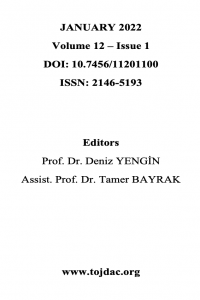Öz
Tasarım faaliyetinin faili olan tasarlayan özne, dahil olduğu eylem uyarınca bir ‘’yeni’’yi araması nedeniyle özgün olmak zorundadır. Tasarlama eyleminin özgün bir temel üzerine inşa edilebilmesi için şu sorunun sorulması uygun olacaktır: Tasarlama eylemi nerede başlar? Bu sorunun muhatabı olan, gündelik yaşantının genel kabullerini sorgusuzca benimsemiş bir insan olduğu varsayılan, eğitimine yeni başlamış tasarım öğrencisinin bu soruya; ‘’tasarım eylemi özne-nesne (Ben-Dünya/Nesne/Somut Şey) arasında başlar’’ cevabını vermesi doğal karşılanabilir.
Gerçekleşmesi muhtemel bu durumun, yaratı eylemi olan tasarımın eğitmeni tarafından soruşturulması ve aşılmasının yolları gözetilmelidir. Özne-nesne düalizminden ziyade, özne-özne (Ben-Ben) ilişkisine yönelmek gerekmektedir. Burada kastedilen, ’’özneler arası’’ yaklaşımının dayandırıldığı bir düşünüm değildir. Öznenin, kendisini nesne haline getirip, refleksif bir tavırla yönelmesiyle, özne, tasarımın başladığı yerin, ‘’özne-nesne ilişkisinin ötesinde bulunduğunu anlama imkanına sahip olabilir.
Kendini aşan, yıkan bir devinimin faaliyeti olan tasarlama eyleminin, yeni’yle kurduğu temas göz önüne alındığında, onu eyleyen, faili olan, tasarlayan özne’nin tazeliğini sorgulamak, araştırmanın var olma nedenidir. Tasarım öğrencisinin tasarlama eylemine yaklaşımı, tasarlanan nesnenin ifade ettiği anlam ve kabuklaşmış tasarım eğitimi kabulleri, temas ettiği alanın düşünümsel zeminini genişleten felsefenin yardımıyla 20.yy filozofu ve yazarı Jean Paul Sartre’ın öne sürdüğü ‘’Kendinde varlık’’, ‘’Kendi için Varlık’’ kavramlarının açısından ele alınarak, Mimar Sinan Güzel Sanatlar Üniversitesi Mimarlık Fakültesi İç Mimarlık Bölümü 1. Sınıf Tasarıma Giriş 2 dersinde üretilen proje üzerinden okunmaya çalışılacaktır.
Anahtar Kelimeler
Kaynakça
- Referans1 Bakewell, S. (2017) ‘’Varoluşçular Kahvesi’’ Çeviren: Emre Gözgü, İstanbul: Elma Basım Yayın S. 153
- Referans2 Peltek, O. (1954) ‘’Existanyelizm Üzerine’’ İstanbul, Kültür Dünyası, S. 20-21
- Referans3 Sartre, J.P. (2005) ‘’Varoluşçuluk’’ Çeviren: Asım Bezirci, Say Yayınları S. 32-33-37-63
- Referans4 Sartre, J.P. (2016) ‘’Ego’nun Aşkınlığı’’ Çeviren: Serdar Rifat Kırkoğlu, İstanbul: Hil Yayınları S. 17-18-19-28
- Referans5 Sartre, J.P. (2017) ‘’Varlık ve Hiçlik’’ Çeviren: Turhan Ilgaz ve Gaye Çankaya Eksen, İstanbul: İthaki Yayınları S. 39-40-41-68-76-77-106
- Referans6 Sartre, J.P. (2012) ‘’Being and Nothingness’’; Çeviren: Hazel E. Barnes, Routledge; Londra: S. 364
- Referans7 URL-1 Öztürk, Ö.B. (2018) ‘’Sürdürülebilirlik Algısının Olgusal Sürdürülemezliği Üzerine Bir Tenkit Denemesi’’ başlıklı makalesi Erişim: https://dergipark.org.tr/tr/download/article-file/408329
- Referans8 URL-2 Öztürk, Ö.B. (2019) ‘’ Evrim-Tasarım İlişkisinin Kusur ve Kusursuzluk Bağlamında Okunması’’ başlıklı makalesi Erişim: https://dergipark.org.tr/tr/download/article-file/743649
- Referans8 URL-3 Türk Dil Kurumu Sözlükleri Erişim: https://sozluk.gov.tr/
Öz
The designing subject/designer, who is the agent of the design activity/design , has to be original since he seeks for a "new" in accordance with the action he involved in. In order for the act of designing/design to be built on a unique basis, it would be appropriate to ask the following question: Where does the act of desingning/desinging begin? The addressee of this question; a design student who has just started his education, assumed to be someone who has adopted the general acceptances of daily life without questioning, is answering this question as “the design activity/design begins between subject-object (I-World/Object/Concrete Thing)" can be seen as normal.
This situation, which is likely to happen, should be investigated by the instructor of this creation, desinging, and ways to overcome it should be considered. It is necessary to focus on the subject-subject (I-I) relationship rather than subject-object dualism. What is meant here is not a reflection upon which the "intersubjective" approach is based. The subject may have the opportunity to understand that the point where the design begins is beyond the "subject-object relationship" by making himself an object and facing it with a reflexive attitude.
It is the reason for the existence of the research to questioning the newness of the subject who acts, who is being an agent and who designs by considering the contact that designing, which is the activity of a movement that surpasses and destroys itself, establishes with the new. The design student's approach to design, the meaning of the designed object and the encrusted design education acceptances will be tried to be understood through the project made in the 1st Year Introduction to Design 2 course of Mimar Sinan Fine Arts University, Faculty of Architecture, Department of Interior Architecture with the help of the philosophy that expands the reflective ground of the area in contact by considering the concepts of “ Being in itself” and “Being for itself” of Jean Paul Sartre, 20th century philosopher and writer.
Anahtar Kelimeler
Kaynakça
- Referans1 Bakewell, S. (2017) ‘’Varoluşçular Kahvesi’’ Çeviren: Emre Gözgü, İstanbul: Elma Basım Yayın S. 153
- Referans2 Peltek, O. (1954) ‘’Existanyelizm Üzerine’’ İstanbul, Kültür Dünyası, S. 20-21
- Referans3 Sartre, J.P. (2005) ‘’Varoluşçuluk’’ Çeviren: Asım Bezirci, Say Yayınları S. 32-33-37-63
- Referans4 Sartre, J.P. (2016) ‘’Ego’nun Aşkınlığı’’ Çeviren: Serdar Rifat Kırkoğlu, İstanbul: Hil Yayınları S. 17-18-19-28
- Referans5 Sartre, J.P. (2017) ‘’Varlık ve Hiçlik’’ Çeviren: Turhan Ilgaz ve Gaye Çankaya Eksen, İstanbul: İthaki Yayınları S. 39-40-41-68-76-77-106
- Referans6 Sartre, J.P. (2012) ‘’Being and Nothingness’’; Çeviren: Hazel E. Barnes, Routledge; Londra: S. 364
- Referans7 URL-1 Öztürk, Ö.B. (2018) ‘’Sürdürülebilirlik Algısının Olgusal Sürdürülemezliği Üzerine Bir Tenkit Denemesi’’ başlıklı makalesi Erişim: https://dergipark.org.tr/tr/download/article-file/408329
- Referans8 URL-2 Öztürk, Ö.B. (2019) ‘’ Evrim-Tasarım İlişkisinin Kusur ve Kusursuzluk Bağlamında Okunması’’ başlıklı makalesi Erişim: https://dergipark.org.tr/tr/download/article-file/743649
- Referans8 URL-3 Türk Dil Kurumu Sözlükleri Erişim: https://sozluk.gov.tr/
Ayrıntılar
| Birincil Dil | Türkçe |
|---|---|
| Bölüm | Makaleler |
| Yazarlar | |
| Yayımlanma Tarihi | 1 Ocak 2022 |
| Gönderilme Tarihi | 11 Ekim 2021 |
| Kabul Tarihi | 16 Kasım 2021 |
| Yayımlandığı Sayı | Yıl 2022 Cilt: 12 Sayı: 1 |
All site content, except where otherwise noted, is licensed under a Creative Common Attribution Licence. (CC-BY-NC 4.0)



